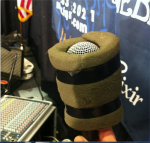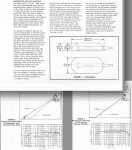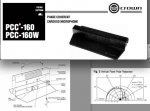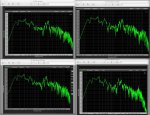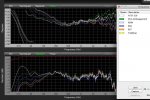A friend on facebook posted a picture of the old bluegrass bass technique of rolling a SM58 in foam and stuffing it in the tailpiece. I happen to think that technique sucks, and I said so backing it up with the statement that blocking the rear ports turns the mic omni. (I thought that was a fair statement in a non technical discussion, I was talking to a bassist, after all)
Another technical person objected to this but never clarified if he thought the term omni wasn't descriptive of the change in pattern that occurs, or if he thought there was no change in pattern.
Any technical discussion of pattern should also include frequency because we know that response also depends on frequency. So there was never any doubt in my mind that "omni" was a simplification, but was it a valid one?
So, having some extra time today, I decided to test it.
First a little mic theory as I understand it:
A common way of mechanically making a mic omni in pattern is to have an enclosed chamber behind the element. This chamber has a fixed amount of air in it; therefore, the pressure and volume change in relationship to each other. This makes the diaphragm react to changes in pressure on the other side. Since sound waves are pressure waves made up of compressions and rarefactions, the vibration of the sound is transferred to the diaphragm regardless of the direction the wave is moving. It may also help to remember work is delta (pressure x volume).
If the rear of the diaphragm is open to the air the sound wave is traveling through, the alternating compressions and rarefactions act on both sides of the diaphragm if the wave is traveling in line with the vibration of the diaphragm. However, a wave coming from 90 degrees to that vibration would act on both sides of the diaphragm equally, canceling out. This creates the figure 8 pattern.
Unidirectional mics are made by adding ports to the air mass at the rear of the diaphragm which increase the amount of time it takes for the wave to arrive. The ports are basically arranged so sound waves arriving from the front of the mic add at the diaphragm, while waves arriving from the rear of the mic cancel at the diaphragm.
So blocking the rear ports would cause the air mass at the rear of the diaphragm to act more and more like a trapped air mass, hence the expectation of omni behavior.
The problem with this simplification is that the open spaces on the rear of the mic ball are not the ports to the rear of the diaphragm. The actual ports are under the mic ball. So part of the question is how much does blocking the rear of the mic ball trap air in the diaphragm chamber?
So I set out to test it...
The first question I had was: What does it mean to be omni? Is an omni pattern the same over all frequencies or is it frequency dependent?
So I started with a test of one of my TR40 measurement mics which is labeled omni

So the first thing I noticed is that at some high enough frequency, the wavelengths become short enough that the mic body itself becomes a physical barrier to the wave. So omni doesn't mean the same at all frequencies from all directions.
So next I test the pattern of a SM58 at close proximity (1 ft) and farther from the source (3 ft). The source was Smaart generated pink noise run through an Equator D5 monitor speaker.


These pretty clearly show the polar pattern and the difference between the top trace (0 degrees) and the other two traces. (90 and 180)
So what happens to the pattern if I wrap the bottom half of the mic ball? I used a piece of bubble wrap, not quite the same as you would see at a bluegrass festival using an open cell foam, but close enough for my interests. The point is block the transmission of the sound wave on part of the mic ball.
Anyway, here is what I got:

Interesting, no real directional differences up to about 250 hz, and once again we can see the same effect in the hf as with the omni mic. What really jumps out at me is that 2000k boost which wasn't there in the unwrapped mic.
So lets look a little closer. Here is 0 degrees wrapped vs unwrapped:

It looks to me like wrapping the mic lowered the proximity effect and added a large boost at 2 k. (That corresponds to what my ears tell me when a vocalist cups the mic)
And here are 90 degrees and 180 degrees:


In both cases, the trace on top over most of the frequency range is the wrapped mic, and they show a response that is much closer to the level of the 0 degree mic, while the unwrapped mic shows the reduction in response we would expect from a unidirectional mic at 90 and 180 degrees. These graphs were from 3 ft, the graphs from 1 ft showed a similar effect that was not quite as pronounced in the frequency range where the proximity effect becomes larger.
So at this point, I think it is fair to say that wrapping the mic changes the pattern of the mic fairly significantly including reducing the proximity effect, taking on attributes of an omni pattern in both the LF and HF ranges, and adding a significant boost around 2k. I have to speculate that feedback problems associated with cupping the mic, result more from this boost than from the omni pattern.
Which leaves the question: What about cupping the mic? In these tests, the mic was wrapped tightly creating an airtight seal. My hand is not big enough to totally surround the mic ball but here are those results:

Not quite as bad of an effect on the directional nature of the pattern, but still that big boost around 2k.
I reran the whole experiment using a supercardioid mic (Samson Q7) and a hypercardioid (EV PL80a) and got similar results.
Of course there has to be part of this that I am not sure about my explanation, and that was observed in the phase response. Both at 1 ft and 3 ft, I observed the phase changing differently with the wrapped mic versus the unwrapped. The wrapped mic started deviating rapidly from the unwrapped mic right where that 2k boost was, and by time it got to the hf the phase was spiraling badly. Since I set the timing in Smaart with the unwrapped mic, I am not sure I can attribute this to anything in particular but since wrapping the mic made changes to the timing of the arrival of the sound wave at both sides of the diaphragm, it does make sense that the phase response was changed.
Another technical person objected to this but never clarified if he thought the term omni wasn't descriptive of the change in pattern that occurs, or if he thought there was no change in pattern.
Any technical discussion of pattern should also include frequency because we know that response also depends on frequency. So there was never any doubt in my mind that "omni" was a simplification, but was it a valid one?
So, having some extra time today, I decided to test it.
First a little mic theory as I understand it:
A common way of mechanically making a mic omni in pattern is to have an enclosed chamber behind the element. This chamber has a fixed amount of air in it; therefore, the pressure and volume change in relationship to each other. This makes the diaphragm react to changes in pressure on the other side. Since sound waves are pressure waves made up of compressions and rarefactions, the vibration of the sound is transferred to the diaphragm regardless of the direction the wave is moving. It may also help to remember work is delta (pressure x volume).
If the rear of the diaphragm is open to the air the sound wave is traveling through, the alternating compressions and rarefactions act on both sides of the diaphragm if the wave is traveling in line with the vibration of the diaphragm. However, a wave coming from 90 degrees to that vibration would act on both sides of the diaphragm equally, canceling out. This creates the figure 8 pattern.
Unidirectional mics are made by adding ports to the air mass at the rear of the diaphragm which increase the amount of time it takes for the wave to arrive. The ports are basically arranged so sound waves arriving from the front of the mic add at the diaphragm, while waves arriving from the rear of the mic cancel at the diaphragm.
So blocking the rear ports would cause the air mass at the rear of the diaphragm to act more and more like a trapped air mass, hence the expectation of omni behavior.
The problem with this simplification is that the open spaces on the rear of the mic ball are not the ports to the rear of the diaphragm. The actual ports are under the mic ball. So part of the question is how much does blocking the rear of the mic ball trap air in the diaphragm chamber?
So I set out to test it...
The first question I had was: What does it mean to be omni? Is an omni pattern the same over all frequencies or is it frequency dependent?
So I started with a test of one of my TR40 measurement mics which is labeled omni

So the first thing I noticed is that at some high enough frequency, the wavelengths become short enough that the mic body itself becomes a physical barrier to the wave. So omni doesn't mean the same at all frequencies from all directions.
So next I test the pattern of a SM58 at close proximity (1 ft) and farther from the source (3 ft). The source was Smaart generated pink noise run through an Equator D5 monitor speaker.


These pretty clearly show the polar pattern and the difference between the top trace (0 degrees) and the other two traces. (90 and 180)
So what happens to the pattern if I wrap the bottom half of the mic ball? I used a piece of bubble wrap, not quite the same as you would see at a bluegrass festival using an open cell foam, but close enough for my interests. The point is block the transmission of the sound wave on part of the mic ball.
Anyway, here is what I got:

Interesting, no real directional differences up to about 250 hz, and once again we can see the same effect in the hf as with the omni mic. What really jumps out at me is that 2000k boost which wasn't there in the unwrapped mic.
So lets look a little closer. Here is 0 degrees wrapped vs unwrapped:

It looks to me like wrapping the mic lowered the proximity effect and added a large boost at 2 k. (That corresponds to what my ears tell me when a vocalist cups the mic)
And here are 90 degrees and 180 degrees:


In both cases, the trace on top over most of the frequency range is the wrapped mic, and they show a response that is much closer to the level of the 0 degree mic, while the unwrapped mic shows the reduction in response we would expect from a unidirectional mic at 90 and 180 degrees. These graphs were from 3 ft, the graphs from 1 ft showed a similar effect that was not quite as pronounced in the frequency range where the proximity effect becomes larger.
So at this point, I think it is fair to say that wrapping the mic changes the pattern of the mic fairly significantly including reducing the proximity effect, taking on attributes of an omni pattern in both the LF and HF ranges, and adding a significant boost around 2k. I have to speculate that feedback problems associated with cupping the mic, result more from this boost than from the omni pattern.
Which leaves the question: What about cupping the mic? In these tests, the mic was wrapped tightly creating an airtight seal. My hand is not big enough to totally surround the mic ball but here are those results:

Not quite as bad of an effect on the directional nature of the pattern, but still that big boost around 2k.
I reran the whole experiment using a supercardioid mic (Samson Q7) and a hypercardioid (EV PL80a) and got similar results.
Of course there has to be part of this that I am not sure about my explanation, and that was observed in the phase response. Both at 1 ft and 3 ft, I observed the phase changing differently with the wrapped mic versus the unwrapped. The wrapped mic started deviating rapidly from the unwrapped mic right where that 2k boost was, and by time it got to the hf the phase was spiraling badly. Since I set the timing in Smaart with the unwrapped mic, I am not sure I can attribute this to anything in particular but since wrapping the mic made changes to the timing of the arrival of the sound wave at both sides of the diaphragm, it does make sense that the phase response was changed.


